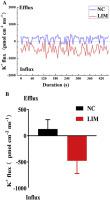当前位置:
X-MOL 学术
›
Arch. Biochem. Biophys.
›
论文详情
Our official English website, www.x-mol.net, welcomes your feedback! (Note: you will need to create a separate account there.)
Disrupted potassium ion homeostasis in ciliary muscle in negative lens-induced myopia in Guinea pigs.
Archives of Biochemistry and Biophysics ( IF 3.9 ) Pub Date : 2020-05-11 , DOI: 10.1016/j.abb.2020.108403 Shanshan Wu 1 , Dadong Guo 2 , Huixia Wei 1 , Xuewei Yin 1 , Liwei Zhang 1 , Bin Guo 1 , Furu Xu 1 , Yixian Hao 1 , Wenjun Jiang 2 , Hongsheng Bi 2
Archives of Biochemistry and Biophysics ( IF 3.9 ) Pub Date : 2020-05-11 , DOI: 10.1016/j.abb.2020.108403 Shanshan Wu 1 , Dadong Guo 2 , Huixia Wei 1 , Xuewei Yin 1 , Liwei Zhang 1 , Bin Guo 1 , Furu Xu 1 , Yixian Hao 1 , Wenjun Jiang 2 , Hongsheng Bi 2
Affiliation

|
Myopia is a main cause of preventable or treatable visual impairment, it has become a major public health issue due to its increasingly high prevalence worldwide. Currently, it is confirmed that the development of myopia is associated with the disorders of accommodation. As a dominant factor for accommodation, ciliary muscle contraction/relaxation can regulate the physiological state of the lens and play a crucial role in the development of myopia. To investigate the relationship between myopia and ciliary muscle, the guinea pigs were randomly divided into a normal control (NC) group and a negative lens-induced myopia (LIM) group, and the animals in each group were further randomly assigned into 2-week (n = 18) and 4-week (n = 21) subgroups in accordance with the duration of myopic induction of 2 and 4 weeks, respectively. In the present study, right eyes of the animals in LIM group were covered with -6.0 D lenses to induce myopia. Next, we performed the haematoxylin and eosin (H&E) staining to observe the pathological change of ciliary muscle, determined the contents of adenosine triphosphate (ATP) and lactate acid (LA), and measured the Na+/K+-ATPase expression and activity in ciliary muscles in both NC and LIM groups. Moreover, we also analyzed the potassium ion (K+) flux in ciliary muscles from 4-week NC and LIM guinea pigs. As a result, we found that the arrangements of ciliary muscles in LIM guinea pigs were broken, dissolved or disorganized; the content of ATP decreased, whereas the content of LA increased in ciliary muscles from LIM guinea pigs. Monitoring of K+ flux in ciliary muscles from LIM guinea pigs demonstrated myopia-triggered K+ influx. Moreover, we also noted a decreased expression of Na+/K+-ATPase (Atp1a1) at both mRNA and protein levels and reduced activity in ciliary muscles from LIM guinea pigs. Overall, our results will facilitate the understanding of the mechanism associated with inhibitory Na+/K+-ATPase in lens-induced myopia and which consequently lead to the disorder of microenvironment within ciliary muscles from LIM guinea pigs, paving the way for a promising adjuvant approach in treating myopia in clinical practice.
中文翻译:

负性晶状体诱发的近视眼豚鼠睫状肌中钾离子稳态的破坏。
近视是可预防或可治疗的视力障碍的主要原因,由于其在世界范围内的患病率越来越高,它已成为主要的公共卫生问题。目前,已经证实近视的发展与适应性疾病有关。作为调节的主要因素,睫状肌收缩/松弛可以调节晶状体的生理状态,并且在近视的发展中起关键作用。为了研究近视与睫状肌的关系,将豚鼠随机分为正常对照组(NC)和阴性晶状体引起的近视(LIM)组,并将每组动物进一步随机分为2周(n = 18)和4周(n = 21)的亚组,分别根据2周和4周的近视诱导时间而定。在目前的研究中,LIM组动物的右眼用-6.0 D透镜遮盖引起近视。接下来,我们进行了苏木精和曙红(H&E)染色以观察睫状肌的病理变化,确定三磷酸腺苷(ATP)和乳酸(LA)的含量,并测量Na + / K + -ATPase在睫状体中的表达和活性NC和LIM组的肌肉。此外,我们还分析了4周NC和LIM豚鼠睫状肌中的钾离子(K +)通量。结果,我们发现LIM豚鼠的睫状肌排列被破坏,溶解或混乱。LIM豚鼠睫状肌中ATP含量降低,而LA含量升高。对LIM豚鼠睫状肌中K +通量的监测表明,近视触发了K +内流。此外,我们还注意到在LIM豚鼠的睫状肌中,在mRNA和蛋白质水平上Na + / K + -ATPase(Atp1a1)的表达均降低,活性降低。总体而言,我们的结果将有助于了解与晶状体引起的近视眼中抑制性Na + / K + -ATPase相关的机制,从而导致LIM豚鼠睫状肌微环境异常,为有希望的辅助方法铺平道路。在临床实践中治疗近视。
更新日期:2020-05-11
中文翻译:

负性晶状体诱发的近视眼豚鼠睫状肌中钾离子稳态的破坏。
近视是可预防或可治疗的视力障碍的主要原因,由于其在世界范围内的患病率越来越高,它已成为主要的公共卫生问题。目前,已经证实近视的发展与适应性疾病有关。作为调节的主要因素,睫状肌收缩/松弛可以调节晶状体的生理状态,并且在近视的发展中起关键作用。为了研究近视与睫状肌的关系,将豚鼠随机分为正常对照组(NC)和阴性晶状体引起的近视(LIM)组,并将每组动物进一步随机分为2周(n = 18)和4周(n = 21)的亚组,分别根据2周和4周的近视诱导时间而定。在目前的研究中,LIM组动物的右眼用-6.0 D透镜遮盖引起近视。接下来,我们进行了苏木精和曙红(H&E)染色以观察睫状肌的病理变化,确定三磷酸腺苷(ATP)和乳酸(LA)的含量,并测量Na + / K + -ATPase在睫状体中的表达和活性NC和LIM组的肌肉。此外,我们还分析了4周NC和LIM豚鼠睫状肌中的钾离子(K +)通量。结果,我们发现LIM豚鼠的睫状肌排列被破坏,溶解或混乱。LIM豚鼠睫状肌中ATP含量降低,而LA含量升高。对LIM豚鼠睫状肌中K +通量的监测表明,近视触发了K +内流。此外,我们还注意到在LIM豚鼠的睫状肌中,在mRNA和蛋白质水平上Na + / K + -ATPase(Atp1a1)的表达均降低,活性降低。总体而言,我们的结果将有助于了解与晶状体引起的近视眼中抑制性Na + / K + -ATPase相关的机制,从而导致LIM豚鼠睫状肌微环境异常,为有希望的辅助方法铺平道路。在临床实践中治疗近视。



























 京公网安备 11010802027423号
京公网安备 11010802027423号